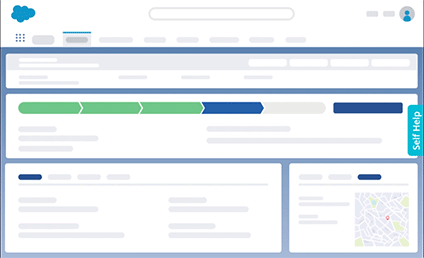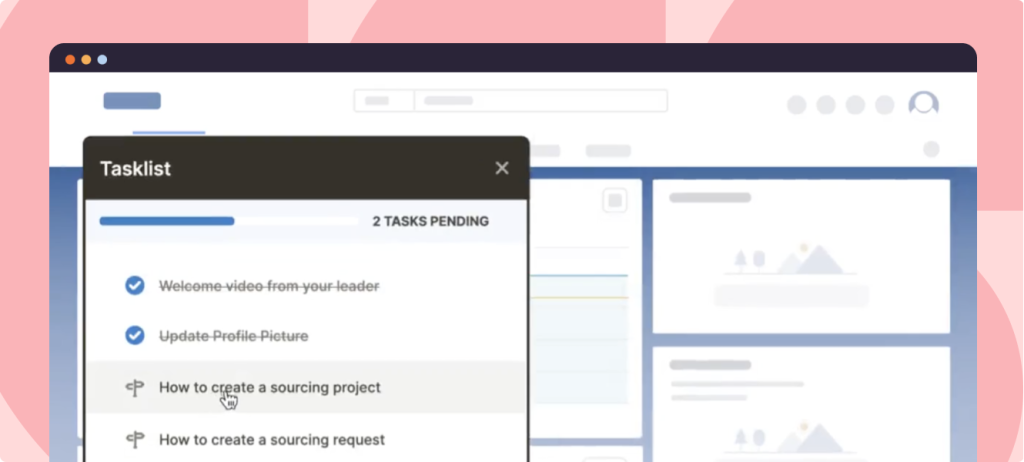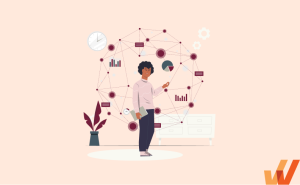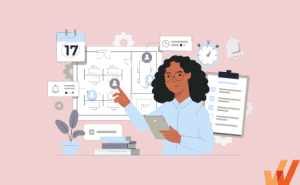The employee experience (EX) is often overlooked. Companies try to build a positive company culture and offer a variety of benefits, but employee experience is more than happy hours and paid time off.
Employee experience design (EXD) can help you design a digital workplace environment that improves employee engagement, satisfaction, and productivity.
Here’s everything you need to know about what employee experience design is and how to create an EXD strategy.
What Is Employee Experience?
Employee experience is the combined whole of every observation and encounter an employee has with a company, starting from the moment they enter the workplace. Employee experience encapsulates what people encounter and observe over the course of their tenure at an organization.
Employee experience design is the process of creating a positive work environment for your workforce. It uses the same principles as customer experience design to ensure employee needs are met throughout the employee lifecycle, starting with recruitment and onboarding and ending with offboarding.
Key Areas of Employee Experience
A well-designed employee experience can improve employee engagement and satisfaction. Key elements of employee experience include:
- Learning and development: Providing the right resources, training, and skill development ensures employees are challenged and engaged.
- Tools and technologies: Equipping employees with the software and technology they need to do their job effectively.
- Physical workplace: For in-office employees, this includes the desk, chair, lighting, temperature, etc., all which impact employees’ ability to focus and be productive. For remote workers, this includes home factors that impact their work, as well as their digital workplace.
- Performance support: Enabling employees to accomplish their goals and daily tasks through contextual performance support, guided experiences, and process documentation.
- Relationships: The interpersonal relationships employees have with their co-workers, including colleagues, managers, leaders, etc.
- Culture and values: Creating a holistic company culture that matches employees’ personal values and expectations.
- Wellness and well-being: Enabling employees to take control of their physical and mental health.
- Feedback and recognition: Supporting employee growth and recognizing and rewarding positive employee contributions.
13 Steps to Create an Effective Employee Experience Design Strategy
Here’s how you can get started building an employee experience design strategy.
1. Define clear objectives and goals
The first step of any successful strategy is to define your goals and objectives. What do you hope to achieve by implementing an employee experience strategy? Some examples include:
- Improved employee engagement
- Keeping employees aware of company-wide changes
- Better work-life balance
- Boosting employee performance
- Boosting talent acquisition and retention
- More diversity and inclusion
When choosing your goals, talk to your teams to better understand what gaps they’re experiencing in the existing employee experience. Working with employees to set your objectives ensures you’re working towards a common goal and helps get them more invested in your future success.
2. Gather employee feedback
When your goals are set, collect feedback and insights from your team. Ask them to share the areas they feel need to be improved and where they feel you’re already doing a good job.
It’s best to collect this kind of feedback anonymously. Employees may be hesitant to share their true feelings if they’re worried it could reflect poorly on them in the future. Give your team an opportunity to share their unfiltered opinions without fearing negative consequences or retaliation.
If possible, collect feedback or insights from past employees as well. Larger companies can use job review boards and social media to see what previous employees liked and didn’t like about working at the company.
3. Segment your employees into cohorts
Your employees will likely have different experiences depending on their positions, responsibilities, and locations. Trying to appeal to all employees the same way will lead to compromises that won’t make anyone happy.
Instead, separate employees into cohorts or segments based on key characteristics and demographics. Identify common factors that would group your employees based on their experience with the company.
For example, employees who work in the office will have a different experience than fully remote teams. Entry-level employees will have a different experience than senior management.
4. Map the employee journey
Consider the journey your employees take throughout their lifecycle with the organization, including how they find and interview for open positions, how they move within the company, and what happens when they leave.
The employee journey will look different for various employee cohorts, so it is important to look at each journey separately.
5. Identify critical touchpoints
When your journey maps are complete, take a look at the critical moments throughout the employee lifecycle. These touchpoints might include an interview, the onboarding process, annual reviews, and offboarding.
At each of these points in the journey, the company has an opportunity to make a lasting impact on the employee — making them the perfect points to ensure a positive employee experience.
6. Develop employee personas
Like customer personas, employee personas help you better understand your employees’ needs, motivations, and goals. Knowing what types of experiences your employees are looking for makes it easier to provide that to them.
In your employee personas, you’ll want to include details such as:
- Career goals, both at the company and beyond
- Personal motivations and objectives
- Employer expectations
- Work-life balance goals
In addition to outlining who your employee is on the job, consider what their life looks like outside of work. A positive employee experience should support your employees’ growth inside and outside of the office.
7. Craft a compelling employee value proposition
An employee value proposition communicates expectations between a company and its employees. It outlines what an employee can expect to receive when working with an organization. Employee value propositions are supposed to attract and retain high-quality talent.
Here’s an example:
We’re committed to helping our employees succeed. With cutting-edge technologies and a culture of innovation, our employees are encouraged to think outside the box and dream big. We believe in a flexible work environment, competitive compensation, and comprehensive benefits that support our employees both inside and outside the workplace. We are future-focused and provide ongoing learning and development opportunities for all employees. When our team members are able to reach their full potential, we all succeed.
8. Design customized experiences for different types of employees
Unique employee experiences will make a stronger impact on your team. Design custom experiences based on the cohorts and pain points you’ve already identified.
Those custom experiences include:
- Customized employee onboarding tailored to each segment’s requirements and contextual training needs
- Contextual, role-based performance support to help employees navigate their tasks and achieve their goals
- Flexible work arrangements that align with employees’ personal schedules
- Well-being programs to support employees at all stages of life
- Personalized recognition and rewards that align with individual goals and values
- Professional employee development plans set for specific role competencies and skill requirements
9. Provide in-app guidance and self-help performance support
Providing personalized support right within your apps is an easy yet impactful way to create better employee experiences. Using a digital adoption platform (DAP) can provide customized instructions, guidance, support, and communication to employees based on their cohort or persona, allows you to deliver personalized experiences at scale.
In-app guidance and self-help performance support also give employees the freedom and flexibility to advance their skills on their own timelines. Giving your employees an opportunity to take control of their development can create a positive work environment.
With a DAP like Whatfix, organizations can enable their employees with use cases such as:
- Task lists to onboard new hires and familiarize them with your software tools, digital processes, and overall workplace guidelines.
- Flows to guide employees step-by-step through complex tasks.
- Self help that provides real-time, moment-of-need support to employees that aggregates all your documentation in one searchable place.
- Pop-ups on your email, CRM, or any software tool to communicate with your employees.
- Smart tips and beacons to highlight or alert employees to contextual information.
- Field validation to ensure the data being entered into your software applications – from an HCM, CRM, ERP – is correctly formatted.
- Surveys to gather employee feedback and sentiment with eNPS surveys, training feedback surveys, quizzes, and more.

10. Implement continuous feedback loops
Continuous feedback loops give employees an opportunity to find where they can grow and develop, as well as share their insights and perspectives on company performance and alignment. You can identify and solve problems faster, enabling employees to be more agile and engaged.
Consider having a tiered approach to employee feedback. More intensive conversations can be had annually or bi-annually, while regular weekly check-ins can ensure everyone is on the same page and moving on the right track.
11. Communicate and train employees
Communication and effective employee training is key to developing your employee experience. As you develop your employee experience design, make sure to clearly communicate the goals, intentions, and expectations.
Provide ample opportunities for upskill training and development to all your team members, including giving them a say in what and when they learn. While there will be company-wide or role-specific training requirements, giving your employees an opportunity to speak up and take control of their career development can improve employee happiness and satisfaction.
12. Empower leadership and managers
A great employee experience needs to start from the top. Just making changes to your company culture isn’t enough to improve employee experience — you need to make sure everyone is on board with living your company values.
This means leadership and managers need to be empowered to make the right decisions for their teams. This includes allowing leadership and managers to:
-
Dictate the work environments and schedules that work best for their teams
-
Provide feedback, rewards, and benefits according to team-specific goals and objectives
-
Have a say in the training and development opportunities provided to their teams
-
Oversee the feedback loops to provide direct advice and insights to the individuals they work closest with
13. Iterate and improve
As with any strategy, there is always going to be room for improvement. As you start to design your employee experience, keep an eye out for opportunities to make changes to deliver an exceptional experience.
Look back at the goals you established at the beginning of the process. Measure if you’ve been successful in achieving those goals and what changes you still need to make. If those goals are no longer relevant, consider setting new ones.
Employee experience improvement should be an ongoing process.
Related Resources
Employee Experience Software
Employee experience management software provides customizable tools for improving employee experience and engagement by collecting and analyzing employee feedback.
These software platforms survey, analyze, and track employees’ feelings about the organization and their work, enabling HR teams to take appropriate actions when and where it matters most.
Here are the best employee experience software according to online reviews:
1. Lattice Engagement
- G2 Rating: 4.6 out of 5 stars
- Price: Starts at $9 per person per month
Lattice Engagement is our top pick for employee engagement management software. This company seeks to improve the experiences team members have during all the many hours they spend at work through scalable and customizable person management.
Its EX platform is focused on 360 reviews and growth planning, feedback, and employee recognition. This software allows managers to perform reviews, monitor engagement data, celebrate achievements, and plan meetings from a single dashboard. The solution is sleek and easy to use for everybody involved, according to its reviews on G2.
Lattice integrates with popular HRIS programs as well as Slack, G Suite, Microsoft Teams, Salesforce, and Jira. Its customer experience team also provides implementation and continued support services.
2. Culture Amp
- G2 Rating: 4.7 out of 5 stars
- Price: The full platform comes in tiered plans based on organization size. Contact the vendor for more information.
Culture Amp is an employee experience platform that equips businesses with tools to monitor and improve employee engagement, performance, and development while promoting enjoyable and feedback-constructed company culture.
Its employee experience tools include robust analytics, pre-fab surveys, and turnover prediction. Culture Amp’s management tools provide opportunities for real-time feedback and enable managers to build teams that excel through purposeful reviews and better meeting planning. It also has growth and development tools, including shared agendas and check-ins, to help team members feel heard and stay in communication.
Culture Amp integrates with HR programs like BambooHR, Workday, Personio, Microsoft Teams, and Slack.
3. Blink
- G2 rating: 4.5
- Pricing: Essential plan starting at $3.40 per person per month.
Blink is an all-in-one employee experience platform designed to give frontline workers a voice. It improves the employee experience in meaningful, everyday ways, giving employees mobile access to the communications and applications they need to do their jobs and feel part of the company.
This creates a productivity, retention, and conversation culture where the frontline is engaged, gives feedback, and feels valued. Key features include a personalized feed, one-to-one & group chats, employee recognition, file sharing, employee hub & directory, and integration with hundreds of workplace systems.
4. 15Five
- G2 Rating: 4.6 out of 5 stars
- Price: Their enterprise platform starts at $14 per person per month
15Five is a positive psychology focused employee experience platform that centers on human experience to help businesses manage employee performance. This employee experience platform has tools for increasing engagement, performance analytics, goal setting, and manager training.
Employee engagement features include engagement assessments, performance reviews, real-time feedback, and employee recognition. This platform integrates with popular communication and HR platforms like Microsoft Teams, Salesforce, Jira, Slack, and BambooHR – it also has a free standalone mobile app for iOS and android.
5. Quantum Workplace
- G2 Rating: 4.5 out of 5 stars
- Price: Starts at $10,000 per year – contact vendor for full details
Quantum Workplace is a wide-ranging business suite centered on improving employee engagement, performance, and growth by helping employers understand what aspects of their overall experience team members find most important where best to focus on improvement. Quantum is an authority in positive workplace experiences and holds annual regional and national contests for “Best Places to Work.”
This software has three components – Engagement, Intelligence, and Performance. Their engagement features consist mainly of different types of survey and related analytics tools that gauge sentiment in different ways at different points of the employee lifecycle. Quantum has a stand-alone mobile app and integrates with Microsoft Teams, Outlook, Google Chrome, and Slack.
People Management Clicks Better With Whatfix
A better employee experience starts with providing better resources, training, and support to your team. Deliver personalized employee experiences right within your platforms and apps with Whatfix.
By providing a comprehensive solution that allows for the analysis of user behavior and the creation of context-sensitive guidance within applications, Whatfix empowers businesses to maximize the efficiency of their workforce. Through personalized on-screen walkthroughs, tooltips, and pop-ups, employees can navigate complex software effortlessly, reducing the learning curve and boosting productivity. In an increasingly digital workplace, platforms like Whatfix are invaluable in ensuring that employees can fully harness the potential of the tools at their disposal, ultimately driving organizational success through improved user adoption and proficiency.
To learn more about Whatfix, schedule a free demo with us today!








